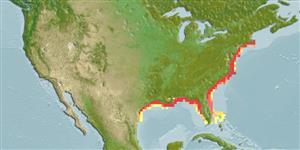Common names from other countries
>
Atheriniformes (Silversides) >
Atherinopsidae (Neotropical silversides) > Menidiinae
Etymology: Menidia: Greek, menoeides, -es, -es = like a half noon shape (Ref. 45335); beryllina: beryllina meaning emerald color (Ref. 10294).
More on author: Cope.
Environment: milieu / climate zone / depth range / distribution range
Ecologia
marinhas; Água doce; estuarina; intervalo de profundidade 0 - 30 m (Ref. 108940). Subtropical; 42°N - 25°N, 98°W - 70°W
Western Atlantic: Massachusetts to southern Florida in USA and around Gulf of Mexico to northeastern Mexico.
Tamanho / Peso / Idade
Maturity: Lm ? range ? - ? cm
Max length : 15.0 cm TL macho/indeterminado; (Ref. 5723); common length : 7.8 cm TL macho/indeterminado; (Ref. 12193); idade máx. registrada: 2.00 anos (Ref. 72478)
Raios anais : 16 - 19; Vértebras: 38 - 42
A brackish/marine species that ascends rivers (Ref. 86798). In fresh water, usually occurs at the surface of clear, quiet water over sand or gravel. Some landlocked populations, many of which have been established in impoundments as forage for sport fishes, reproduce in fresh water (Ref. 5723). Feeds on zooplankton (Ref. 10294), invertebrates, fish eggs and larvae and diatoms (Ref. 93252).
Ciclo de vida ou comportamento de acasalamento
Maturidade | Reprodução | Desova | Ovos | Fecundidade | Larvas
Robins, C.R. and G.C. Ray, 1986. A field guide to Atlantic coast fishes of North America. Houghton Mifflin Company, Boston, U.S.A. 354 p. (Ref. 7251)
Status na Lista Vermelha da UICN (Ref. 130435)
CITES (Ref. 128078)
Not Evaluated
Ameaça para os humanos
Harmless
Uso pelos humanos
Mais informação
ColaboradoresFotosStamps, Coins Misc.SonsCiguateraVelocidadeTipo de nataçãoÁrea branquialOtólitosCérebrosVisão
Ferramentas
Relatórios especiais
Baixar XML
Fontes da internet
Estimates based on models
Preferred temperature (Ref.
115969): 12.7 - 26.1, mean 23.7 (based on 181 cells).
Índice de diversidade filogenética (Ref.
82804): PD
50 = 0.5039 [Uniqueness, from 0.5 = low to 2.0 = high].
Bayesian length-weight: a=0.00513 (0.00229 - 0.01150), b=3.08 (2.89 - 3.27), in cm Total Length, based on LWR estimates for this (Sub)family-body shape (Ref.
93245).
Nível Trófico (Ref.
69278): 3.2 ±0.3 se; based on size and trophs of closest relatives
Resiliência (Ref.
120179): Elevada, tempo mínimo de duplicação da população menor que 15 meses (tmax=1).
Fishing Vulnerability (Ref.
59153): Low vulnerability (10 of 100).
